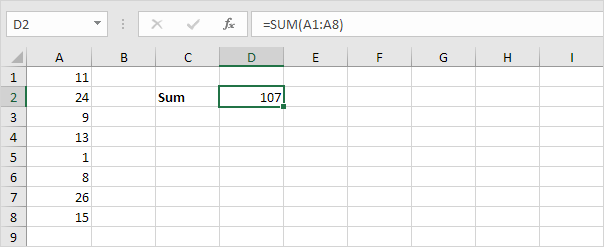

- #HOW TO SUM A COLUMN IN EXCEL WITH ERRORS HOW TO#
- #HOW TO SUM A COLUMN IN EXCEL WITH ERRORS DOWNLOAD#

The error values have disappeared from the pivot table, and the counts for each Region are showing correctly. Because of its non-numeric values, Excel automatically used the Count summary function for the data. To fix that problem, I moved the Total field to the Values area. (Excel put Total in the Rows area because it has non-numeric data.) When I added the Region and Total fields, Excel put both fields into the Row area, with the errors showing as items for the Total field. To see how Excel handles these errors, I created a new pivot table, based on that table.
#HOW TO SUM A COLUMN IN EXCEL WITH ERRORS DOWNLOAD#
You can download this sample file from the Pivot Table Summary Functions page on my Contextures website. Two cells (C4 and E9) contain text, instead of the numbers that should be in those columns.There is a blank cell (E7), where a formula has been deleted.There are three #DIV/0 errors, because Excel can’t divide by zero.There is text in cell C4, so the formula in E4 has a #VALUE! error, instead of a numeric result.In the screen shot below, there is a small Excel table, with several errors and missing or invalid data.

See which Summary Functions show those errors, and which ones don’t (most of the time!) We guarantee a connection within 30 seconds and a customized solution within 20 minutes.Īre you still looking for help with the Average function? View our comprehensive round-up of Average function tutorials here.If there are errors in an Excel table, you might see those errors when you summarize that data in a pivot table. If you want to save hours of research and frustration, try our live Excelchat service! Our Excel Experts are available 24/7 to answer any Excel question you may have. Most of the time, the problem you will need to solve will be more complex than a simple application of a formula or function. Instant Connection to an Expert through our Excelchat Service Like the AVERAGEIF function, the AGGREGATE function also returns with the same answer. “1” specifies average while “6” represents the option to ignore errors. AVERAGEIF returns the average of the values that are greater than or equal to zero in the specified range, thus, filtering out any errors in the data. The term “values” represents the range of the data: B5:B14.
#HOW TO SUM A COLUMN IN EXCEL WITH ERRORS HOW TO#


 0 kommentar(er)
0 kommentar(er)
